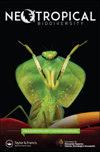El uso de gremios tróficos en macroinvertebrados acuáticos como herramienta de monitoreo en los Altos Andes del Sur de Ecuador
IF 0.8
Q4 ECOLOGY
引用次数: 3
Abstract
ABSTRACT Aquatic macroinvertebrates are widely used as indicators of water quality. However, in the Andean region of Ecuador, little is known about how the macroinvertebrate community assemblage responds to changes in the habitat where they occur. One of the main drawbacks is taxonomy, where classifying organisms on a full taxonomic scale becomes complicated. To resolve this point, in a in a NMDS (non-metric multidimensional scaling) ordination analysis, the abundance of macroinvertebrates obtained in 12 monitoring stations in the Cajas Massif, southern Ecuador, was used. The rankings were contrasted using the trophic guilds approach versus the family taxonomic approach (the maximum taxonomic classification available). The ordering analyzes showed a more differentiated spatial organization with the trophic guilds approach than with the family-level approach. When explaining the organization of the communities, the ABI (Andean Biotic Index) and the elevation, significantly explains the organization of the community from the trophic guilds approach; although, only the elevation explains the ordering from the family scale approach. The results suggest that, from the trophic guilds approach, a better approximation of the general ecological role of the macroinvertebrate community associated with environmental services such as water quality is represented. Guilds such as shredders, scrapers, and detritivores adjust to increasing ABI (i.e. water quality). Consequently, monitoring with a focus on the trophic guilds can be used in studies of water quality and its relationship with the community.厄瓜多尔南部安第斯山脉上游水生大型无脊椎动物营养协会作为监测工具的使用
摘要水生大型无脊椎动物被广泛用作水质指标。然而,在厄瓜多尔的安第斯地区,人们对大型无脊椎动物群落如何应对栖息地的变化知之甚少。一个主要的缺点是分类学,在分类学上对生物进行全面分类变得复杂。为了解决这一点,在NMDS(非度量多维尺度)排序分析中,使用了厄瓜多尔南部Cajas Massif 12个监测站获得的大型无脊椎动物丰度。使用营养行会方法与家族分类学方法(可用的最大分类法)对排名进行对比。排序分析显示,与家庭水平的方法相比,营养行会方法的空间组织更加分化。在解释群落的组织时,ABI(安第斯生物指数)和海拔高度,从营养行会的方法显著解释了群落的组织;不过,只有立面可以解释族比例方法的顺序。结果表明,从营养行会的方法来看,与水质等环境服务相关的大型无脊椎动物群落的总体生态作用得到了更好的近似。切碎机、刮刀和碎石机等行业会根据ABI(即水质)的增加进行调整。因此,以营养群为重点的监测可用于研究水质及其与社区的关系。
本文章由计算机程序翻译,如有差异,请以英文原文为准。
求助全文
约1分钟内获得全文
求助全文
来源期刊

Neotropical Biodiversity
Environmental Science-Ecology
CiteScore
1.80
自引率
0.00%
发文量
39
审稿时长
24 weeks
 求助内容:
求助内容: 应助结果提醒方式:
应助结果提醒方式:


